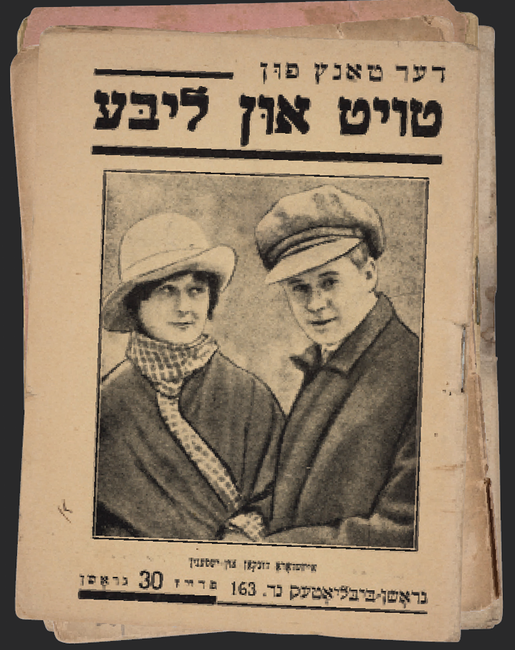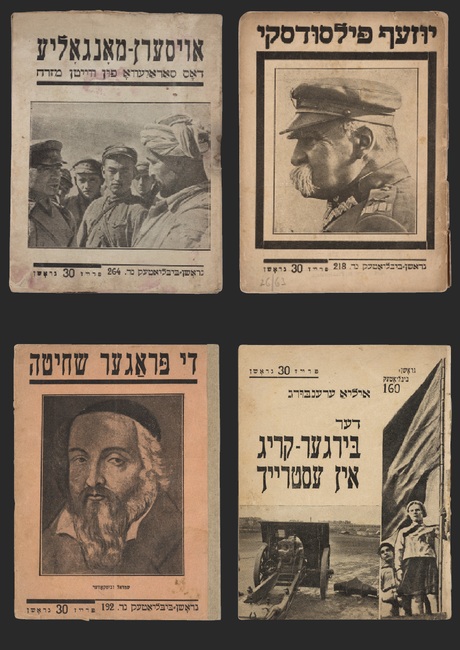
The Worker’s Library
Groshn-biblyotek Helped Anxious Readers Make Sense of Their Times
- Written by:
- David Mazower and Lyudmila Sholokhova
- Published:
- Fall 2016 / 5777
- Part of issue number:
- 74

Apart from their fame (or notoriety), what do Mata Hari, Emil Zola, Charles Lindbergh, Hitler, and Sholem Aleichem have in common?
They were all subjects in a remarkable Yiddish publishing project: the Groshn-biblyotek, or Penny Library. Aimed at Yiddish-speaking workers in 1930s Poland, this ambitious venture ran for seven years, over that time developing into an influential and popular library of Jewish and general knowledge.
Small enough to slip easily into a pocket, the Groshn-biblyotek booklets were part of a much wider phenomenon—the popular thirst for knowledge in the decades before and after 1900. Across Europe, workers with limited formal education were intent on self-improvement. There were dozens of “libraries” for Polish, Hebrew, and Yiddish readers in Poland alone. They varied widely in subject matter and longevity, but all were cheap and affordable. So, for example, in 1909–11, the Warsaw publisher Binyomin Shimin issued Shimin’s groyse velt bibliotek (Shimin’s Great World Library), a series of sixty-six booklets ranging in topic from popular science to history to world literature. In England, publisher Ernest Benn issued Benn’s Sixpenny Library in the late 1920s with more than 250 general knowledge titles including The Atom, The Papacy, and Roman Britain.
The Groshn-biblyotek was
unusual in its range, its readership, and its political orientation.
The Groshn-biblyotek, however, was unusual in its range, its readership, and its political orientation. The series got under way in 1930 with a tabloid agenda of spies, love, sex, crime, and assassinations. Booklet no. 1, Mata Hari, the Dancer and Spy, was swiftly followed by American Millionaires, Geniuses with Syphilis, and Manolescu, King of Swindlers (no doubt inspired by the 1929 film of that name). As the series developed, however, these sensational subjects were gradually diluted by a more socially aware and politically radical agenda. By the mid-1930s, contemporary politics and the fight against anti-Semitism and fascism were key themes of the library. There was a booklet on Horst Wessel, the Nazi activist and propaganda symbol; a two-part profile of Soviet Communist leader Karl Radek; and many issues devoted to contemporary Polish politics.
Pamphlets were issued weekly with a standard format of sixty-four pages per issue. As with the famous Penguin Books or Benn’s Sixpenny Library, price was a key selling point: each pamphlet cost thirty groschen. Print runs were another unusual feature. Most Yiddish books were issued in editions of no more than 1,000 copies. The average print run of a Groshn-biblyotek brochure was between 4,000 and 20,000 copies. Finally, there was another innovation: the drab early covers, typical of most Yiddish publications, were replaced by bold full-cover photographs.

The Groshn-biblyotek commissioned around a dozen journalists and historians to write the pamphlets, demanding accuracy combined with an engaging style. By far the most prolific contributor was Yankev-Kopl Dua (1898–1942). Born into great poverty, Dua’s own education had been disrupted by World War I. Active as a translator, private tutor, and adult-education lecturer, he was a fluent and exceptionally quick writer.
“Paralyzed in both legs, he spent most of his time in bed and wrote half sitting up and leaning on pillows,” journalist Chaim (Khayim) Finkelstein wrote of Dua. “On the rare days when Dua went outside, he dragged himself with a great effort to Schultz’s Restaurant at the corner of Carmelicka and Nowolipki streets . . . a tavern where people would drop in for a little schnapps chased by a piece of herring or a serving of chopped liver . . . Over a mug of beer, Dua would debate for hours with young writers and labor activists for whom the tavern was a place of shelter.”
Dua, an autodidact writing for fellow autodidacts, masked his prolific output with a variety of pseudonyms. He was involved with Groshn-biblyotek from the start and continued right up until the final titles featuring Sigmund Freud, Leon Blum (the first Socialist—and the first Jewish—prime minister of France), and Genghis Khan. In a sense, the Groshn-biblyotek serves as Dua’s memorial: he was confined in the Warsaw ghetto and shot on the street by a Nazi officer in September 1942.
Despite being published in large numbers, very few copies of the Groshn-biblyotek have survived, and few major libraries in Israel, Poland, or the United States have anything approaching a full set. That’s also a measure of how avidly these flimsy, yellowing booklets were read in the city and the shtetl, how they were passed from hand to hand. Today they serve as a mirror of the wide interests, concerns, and tastes of a mass Polish Jewish readership in the 1930s. At a time of growing international tension and worsening anti-Semitism in Poland and abroad, the Groshn- biblyotek helped anxious readers make sense of their times.
The library’s own advertising team got it about right when they posed the question, “What is the Groshn-biblyotek?” in one of the early brochures. By way of an answer, they promised to “not make up stories but provide historically accurate and well-written truths drawn from real life . . . illuminate the lives and struggles of great individuals . . . lead the reader into the laboratories of great scientists . . . describe far-off places and unknown lands [and] give everyone the chance to assemble a fine home library and participate in the general cultural development.” It’s an accurate summary of their achievement, and a fitting epitaph.
